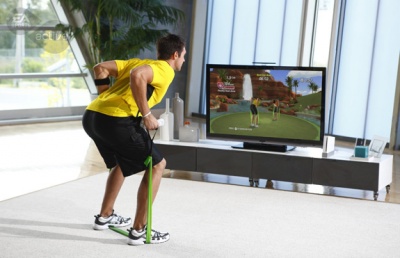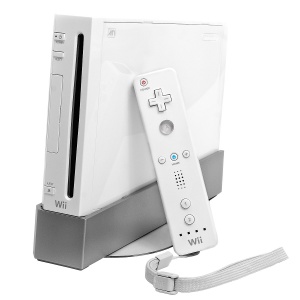Difference between revisions of "Fitness Game"
m |
|||
| Line 1: | Line 1: | ||
[[File:FitnessGame1.jpg|400px|thumb|right|A man playing a fitness game.]] | [[File:FitnessGame1.jpg|400px|thumb|right|A man playing a fitness game.]] | ||
| − | '''Fitness Game''' refers to a type of online video game that specifically demands players to | + | '''Fitness Game''' refers to a type of online video game that specifically demands players to exert physical activity as a part of the gameplay. When companies like Nintendo and Konami have introduced the concept of fitness game in the 1980's-1990's, the cost for the supporting technology was expensive and its technological capability was still behind in fully grabbing consumers' attention. The introduction of motion control by Nintendo's Wii and Microsoft's Xbox enhanced both the features and the efficiency of fitness game. The field of fitness game grew in popularity because the games enabled the consumers to get real exercise. |
| − | + | ||
| − | + | ||
| − | + | ||
| − | + | ||
==Before the 21st century== | ==Before the 21st century== | ||
| − | |||
===Life Fitness Exertainment System=== | ===Life Fitness Exertainment System=== | ||
| Line 13: | Line 8: | ||
[[File:FitnessGame2.jpg|200px|thumb|right|A woman exercising on the Life Fitness Exertainment System.]] | [[File:FitnessGame2.jpg|200px|thumb|right|A woman exercising on the Life Fitness Exertainment System.]] | ||
The '''Life Fitness Exertainment System''' is an exercise bike made by Life Fitness (a manufacturer of exercise equipment) in collaboration with Nintendo. It was released in the US in the 1990's and offered compatibility with the Super Nintendo console. Designed to allow the player to exercise while playing video games, Life Fitness Exertainment System shows similarity with Wii Fit, only the system was produced over a decade earlier. A few games were designed to be used with the Exertainment bike, like ''Speed Racer in My Most Dangerous Adventures''<ref>"Nintendo Wikia of Speed Racer in My Most Dangerous Adventures"http://nintendo.wikia.com/wiki/Speed_Racer_in_My_Most_Dangerous_Adventures</ref> and ''Exertainment Mountain Bike Rally''<ref>"Nintendo Wikia of Exertainment Mountain | The '''Life Fitness Exertainment System''' is an exercise bike made by Life Fitness (a manufacturer of exercise equipment) in collaboration with Nintendo. It was released in the US in the 1990's and offered compatibility with the Super Nintendo console. Designed to allow the player to exercise while playing video games, Life Fitness Exertainment System shows similarity with Wii Fit, only the system was produced over a decade earlier. A few games were designed to be used with the Exertainment bike, like ''Speed Racer in My Most Dangerous Adventures''<ref>"Nintendo Wikia of Speed Racer in My Most Dangerous Adventures"http://nintendo.wikia.com/wiki/Speed_Racer_in_My_Most_Dangerous_Adventures</ref> and ''Exertainment Mountain Bike Rally''<ref>"Nintendo Wikia of Exertainment Mountain | ||
| − | + | Bike Rally"http://nintendo.wikia.com/wiki/Exertainment_Mountain_Bike_Rally</ref>. There were multiple problems that arose and ultimately marked the failure of this project. The first problem was the cost of the system. The model itself was more expensive than a typical exercise bike given that there were additional costs of electronics to institute the gaming features. The high production costs made it not cost effective for mass production. There were also issues with production quality. The model was not durable and broke easily. Durability is an important characteristic for any useful fitness equipment to have, thus this model received backlash from consumers in the market. Lastly, users found operating the gaming software intimidating. The software lacked instructions on how to use the product , and users felt uncomfortable having to employ software knowledge in order to exercise. | |
===Dance Dance Revolution=== | ===Dance Dance Revolution=== | ||
[[File:FitnessGame3.jpg|300px|thumb|right|Two men playing Dance Dance Revolution on the dancing stage.]] | [[File:FitnessGame3.jpg|300px|thumb|right|Two men playing Dance Dance Revolution on the dancing stage.]] | ||
| − | '''Dance Dance Revolution (DDR)''' was produced by a Japanese entertainment and gaming company called Konami in 1998. | + | '''Dance Dance Revolution (DDR)''' was produced by a Japanese entertainment and gaming company called Konami in 1998. Dandce Dance Revolution is a music video game series that pioneered the rhythmic dancing game market. To play, players stand on a ''dance platform'' and step on the colored arrows according to the visual cues which follow along to the rhythm of a song. Once the round is finished, players are judged by how well they timed their "dance" steps. Players earn a higher score if they accurately connected with visual cues with the rhythm. The winning player has the option to continue to the next round and play again. |
| − | ''Dance Dance Revolution'' has been given much critical acclaim for its originality and longevity in the video game market. There have been numerous arcade-based launches across 20 countries | + | ''Dance Dance Revolution'' has been given much critical acclaim for its originality and longevity in the video game market. Dance Dance Revolution is considered a home and arcade game because of the versatility to be played in both environments. It is a game that can be enjoyed by just one person or ten people. There have been numerous arcade-based launches across 20 countries. In these arcades, dancers often have dance battles against one another to see who can earn the highest score on the game. There have been hundreds of Dance Dance Revolution home video game console release where consumers can purchase their own mats to play or play from their hand-held consoles. In its 20 years,''Dance Dance Revolution'' has promoted a music library of original songs produced by Konami's artists and a set of licensed music from many different genres while prompting inspiration for similar musical games. |
==After the 21st century== | ==After the 21st century== | ||
| − | Beginning in the 21st century | + | Beginning in the 21st century, the field of fitness games made a dramatic development due to several technological advancements. These technological developments, including motion control and wearable technology, became a major part of the newest fitness games. |
| + | |||
===Nintendo's Wii=== | ===Nintendo's Wii=== | ||
[[File:FitnessGame4.jpg|300px|thumb|right|Wii Console.]] | [[File:FitnessGame4.jpg|300px|thumb|right|Wii Console.]] | ||
| − | Released in November 2012 by Nintendo<ref>"Wii U Confirmed Release Date"http://metro.co.uk/2012/01/26/wii-u-confirmed-for-europe-this-year-297126/</ref>, the '''Wii U''' is the first eighth-generation video game console presented in the video game market<ref>"Article about eighth-generation console"http://www.businessinsider.com/nintendos-project-cafe-will-gamers-feel-the-buzz-2011-5</ref>. The ''Wii U'' is also the first video game console to introduce the concept of motion control, a technological capability to accurately depict player's physical motion and encrypt such motion into the gaming interface. This feature greatly enhanced the accuracy of fitness games because it can track the exact motion a player makes, thus creating a more interactive gaming interface for the players while tracking exercise. | + | In late 2006, Wii came out with Wii Sports Club<ref>"Nintendo Website" https://www.nintendo.com/games/detail/23dwBGv7QCFrP08BKcqDpsq-6hxvaaTB</ref>. In Wii Sports, players can actively engage in the video game by physically doing the motion of "hitting" a tennis ball or "swinging" a golf club to hit a golf ball, along with other motions <ref>"Nintendo Website" https://www.nintendo.com/games/detail/23dwBGv7QCFrP08BKcqDpsq-6hxvaaTB</ref>. Many of these motions, including others, activates the user's muscles in the game to incorporate a physical component to a traditionally stationary game. Released in November 2012 by Nintendo<ref>"Wii U Confirmed Release Date"http://metro.co.uk/2012/01/26/wii-u-confirmed-for-europe-this-year-297126/</ref>, the '''Wii U''' is the first eighth-generation video game console presented in the video game market<ref>"Article about eighth-generation console"http://www.businessinsider.com/nintendos-project-cafe-will-gamers-feel-the-buzz-2011-5</ref>. The ''Wii U'' is also the first video game console to introduce the concept of motion control, a technological capability to accurately depict player's physical motion and encrypt such motion into the gaming interface. This feature greatly enhanced the accuracy of fitness games because it can track the exact motion a player makes, thus creating a more interactive gaming interface for the players while tracking exercise. The Wii Fit U was created in October of 2013 to pair with the Wii U console. Players used the Wii Balance Board accessory to do physical activities such as yoga, strength exercises, balance games, aerobic activities, dance, and more <ref> https://www.nintendo.com/games/detail/wii-fit-u-packaged-version-wii-u </ref>. The Fit Meter accessory was also paired with the Wii Fit U so users could track their calories burned from steps, and when synced with the Wii Fit U, a user's progress over time could be shown <ref> https://www.nintendo.com/games/detail/wii-fit-u-packaged-version-wii-u </ref>. |
| + | Just Dance<ref>"Just Dance Ubisoft Website"https://just-dance.ubisoft.com/en-us/home/</ref>, and Nike+ Kinect Training<ref>"Nike+ | ||
| + | |||
Below is the list of Wii games that utilize motion control. | Below is the list of Wii games that utilize motion control. | ||
{| class="wikitable" | {| class="wikitable" | ||
| Line 64: | Line 62: | ||
| Rhythmical Dance Game | | Rhythmical Dance Game | ||
|} | |} | ||
| + | Kinect Training Demo https://www.youtube.com/watch?v=CoM_MNZ5pzU</ref>. | ||
| + | |||
===Smartphone, Wearables, and Exantra World=== | ===Smartphone, Wearables, and Exantra World=== | ||
| − | Wearable | + | The launch of wearable devices like Fitbit<ref>"Fitbit Website"https://www.fitbit.com/home</ref> and Apple Watch<ref>"Apple Watch Website"https://www.apple.com/apple-watch-series-3/?afid=p238%7Cs2QbmM6cp-dc_mtid_1870765e38482_pcrid_224100368864_&cid=aos-us-kwgo-watch--slid--product-</ref> initiated many developments to the fitness game industry. Wearable devices can sync their data collected and observed such as the user's heartbeat; one example of a fitness game that utilizes wearables is Exantra World<ref>"Exantra World Website"https://www.exantraworld.com/</ref>. Wearable influence the field of fitness games because of their portability and ease of use. This allows users to be more efficient when exercising, all while experiencing high-end technological gaming interfaces. There are numerous fitness apps that are paired with wearable technologies, utilizing its real-time data collection through tracking the users' movement and bodily to provide feedback metrics and progress indicators to the user. This enhances the physical gaming experience for users as they can check their progress throughout the day to ensure they are meeting their physical goals. In combination with a game, users can enjoy an interactive and competitive experience by working to beat their high scores or unlock new levels. |
[[File:FitnessGame5.png|500px|thumb|right|Exantra World illustration.]] | [[File:FitnessGame5.png|500px|thumb|right|Exantra World illustration.]] | ||
| − | '''Exantra World''' is the first Online Role-Playing fitness app (iOS) that allows players to build their own avatar, known as a Titan. The app prompts users to strengthen their Titans by statistically increasing their abilities with virtual points. Once their Titans get strong enough, users can compete with other Titans. | + | '''Exantra World''' is the first Online Role-Playing fitness app (iOS) that allows players to build their own avatar, known as a Titan. The app prompts users to strengthen their Titans by statistically increasing their abilities with virtual points. Once their Titans get strong enough, users can compete with other Titans.''Exantra World'' is technologically advanced due because of its simultaneous utilization of wearable technology and a smartphone. When the user begins to exercise, wearable technologies measure the increase in the user's heart rate and analyzes the heat-rate intensity. The technology then sends the heart rate data to the game and the game converts the data into virtual points. The user can later spend their virtual points to develop his or her own Titan and play the game. |
| − | + | ||
==Ethical Concerns== | ==Ethical Concerns== | ||
| − | One of the greatest concerns facing fitness games is health information privacy and how user information is used. As wearables are | + | One of the greatest concerns facing fitness games is health information privacy and how user information is used. As wearables are more integrated into fitness game, collecting and sharing user health data is becoming more efficient and easier to do. |
| + | |||
| + | ===Health Information and its Utilization=== | ||
| + | Users playing fitness games during late 1990s and throughout the 2000s did not have an issue with sharing their health information nor with how their information was used. With the rise of the fitness game industry, sharing and using user's health information became the major ethical dilemma as video-game companies began incorporating modern technology into their fitness game developments. There are security breaches where hackers tap into the data collection of user's health information. This information can also be used for specific marketing and customer segmentation efforts. Information like this is meant to be kept private unless the user provides consent to have it distributed. The sharing of this personal data between fitness game softwares and wearable technologies is a way that personal information can get lost or accessed by authorized people. | ||
| − | + | For example, in case of Exantra World, players are continuously exposed to the game interface and the wearable technology while they are playing the game. Once the wearable has accumulated enough health information about the player, it will then transmit that information to the smartphone device and convert the player's health information into virtual points. This illustrates the circumstance in which player's health information could be exposed to the entire gaming interface and therefore is not secure. Possible consequences of this would be publicizing one's health information, which is very private data. | |
| − | + | ||
| − | For example, in case of Exantra World, players are continuously exposed to the game interface and the wearable technology while | + | |
===Credibility of Generalized Workout=== | ===Credibility of Generalized Workout=== | ||
| − | This issue fundamentally questions the efficiency of many fitness games on the market. In real life, a personal trainer has | + | This issue fundamentally questions the efficiency of many fitness games on the market. In real life, a personal trainer has a personal trainer certification, like American Council on Exercise (ACE)<ref>"ACE Website"https://www.acefitness.org/fitness-certifications/personal-trainer-certification/default.aspx?utm_campaign=Banner_Ads&utm_content=PT_Career_Guide_160x600#personal-trainer-marketing-download&utm_source=Rakuten&utm_medium=4&ranMID=42334&ranEAID=nuU3r0LI7IY&ranSiteID=nuU3r0LI7IY-z4ahl3I7Oi5OJxyKDUbk1g</ref> or National Academy of Sports Medicine (NASM)<ref>"NASM Website"https://www.nasm.org/become-a-personal-trainer?utm_source=cj&utm_medium=affiliate&utm_campaign=Bolt+Fitness&utm_content=7356170</ref> to certify that he or she is a credible resource for safe exercises that are personally suited to the client. This is not the case in fitness games. There is no certification that gives credibility to the type of exercise that the player can do in a fitness game. There is no guarantee that the type of exercises that a player does through the fitness game is going to be beneficial or safe given the player's physical condition. Since there is no trainer physically present, it is up to the wearable technology to determine at what point a workout is no longer beneficial or even harmful to a player. Stories about people getting injured from playing the Nintendo Wii come up often. A common injury called, "Wii knee" is a term used to encompass all knee related injuries when playing Wii. The first report of this type of injury came from a young girl who dislocated part of her knee from playing Wii tennis <ref>"the bmj" https://www.bmj.com/content/349/bmj.g7267</ref>. These type of injuries occur from most sports such as tennis, bowling, and golf. Due to the lack of data about the benefits of playing Wii sports, it is difficult to understand how much physical workout one's body needs from playing Wii and its positive impacts. Programs are not yet sophisticated enough to explain their logic behind the specific workouts they recommend to everyday users. Wearable health programs are thinking like humans, but they also cannot explain these decisions to their users which can cause serious injuries. <ref>Doshi-Velez, Finale and Mason Kortz. "AI is more powerful than ever. How do we hold it accountable?" 20 March 2018, https://www.washingtonpost.com/outlook/ai-is-more-powerful-than-ever-how-do-we-hold-it-accountable/2018/03/20/e867b98a-2705-11e8-bc72-077aa4dab9ef_story.html?utm_term=.0048934e43e1. Accessed 26 March 2018.</ref> |
===Technological Bias=== | ===Technological Bias=== | ||
| − | As both old and new fitness games continue to | + | As both old and new fitness games continue to grow in popularity, there are many uncertainties in the ethical standards with which these games are being constructed. Alison Adams says that consumers should not expect new technologies to be completely different from old technology as they have similar designs and production method.<ref>Adam, Alison. Cambridge Handbook, Chapter 9, “Personal values and computer ethics.” </ref> Adam's touches on many issues arising within their field. First, there is still a large portion of these technologies which is coded by humans. Humans have biases and have the can code software that embodies these biases, unintentional or not. Additionally, the people creating these algorithms are not necessarily trained to be creating these workouts. These software engineers may not understand what each is considered "safe" motions for practicing different sports or activities. Similarly, those who create the technology can be targeting certain groups, particularly women, with unrealistic body expectations, which are evident in proportionally harder workouts. By targeting women and marketing unrealistic outcomes, the game is perpetuating body size stigmas and norms by offering generalized workouts that are better suited to a person's specific body type. This misleads users and imposes potential adverse effects of what the user's perception of appropriate physical activity is. |
==References== | ==References== | ||
Revision as of 18:59, 30 March 2018
Fitness Game refers to a type of online video game that specifically demands players to exert physical activity as a part of the gameplay. When companies like Nintendo and Konami have introduced the concept of fitness game in the 1980's-1990's, the cost for the supporting technology was expensive and its technological capability was still behind in fully grabbing consumers' attention. The introduction of motion control by Nintendo's Wii and Microsoft's Xbox enhanced both the features and the efficiency of fitness game. The field of fitness game grew in popularity because the games enabled the consumers to get real exercise.
Before the 21st century
Life Fitness Exertainment System
The Life Fitness Exertainment System is an exercise bike made by Life Fitness (a manufacturer of exercise equipment) in collaboration with Nintendo. It was released in the US in the 1990's and offered compatibility with the Super Nintendo console. Designed to allow the player to exercise while playing video games, Life Fitness Exertainment System shows similarity with Wii Fit, only the system was produced over a decade earlier. A few games were designed to be used with the Exertainment bike, like Speed Racer in My Most Dangerous Adventures[1] and Exertainment Mountain Bike Rally[2]. There were multiple problems that arose and ultimately marked the failure of this project. The first problem was the cost of the system. The model itself was more expensive than a typical exercise bike given that there were additional costs of electronics to institute the gaming features. The high production costs made it not cost effective for mass production. There were also issues with production quality. The model was not durable and broke easily. Durability is an important characteristic for any useful fitness equipment to have, thus this model received backlash from consumers in the market. Lastly, users found operating the gaming software intimidating. The software lacked instructions on how to use the product , and users felt uncomfortable having to employ software knowledge in order to exercise.
Dance Dance Revolution
Dance Dance Revolution (DDR) was produced by a Japanese entertainment and gaming company called Konami in 1998. Dandce Dance Revolution is a music video game series that pioneered the rhythmic dancing game market. To play, players stand on a dance platform and step on the colored arrows according to the visual cues which follow along to the rhythm of a song. Once the round is finished, players are judged by how well they timed their "dance" steps. Players earn a higher score if they accurately connected with visual cues with the rhythm. The winning player has the option to continue to the next round and play again. Dance Dance Revolution has been given much critical acclaim for its originality and longevity in the video game market. Dance Dance Revolution is considered a home and arcade game because of the versatility to be played in both environments. It is a game that can be enjoyed by just one person or ten people. There have been numerous arcade-based launches across 20 countries. In these arcades, dancers often have dance battles against one another to see who can earn the highest score on the game. There have been hundreds of Dance Dance Revolution home video game console release where consumers can purchase their own mats to play or play from their hand-held consoles. In its 20 years,Dance Dance Revolution has promoted a music library of original songs produced by Konami's artists and a set of licensed music from many different genres while prompting inspiration for similar musical games.
After the 21st century
Beginning in the 21st century, the field of fitness games made a dramatic development due to several technological advancements. These technological developments, including motion control and wearable technology, became a major part of the newest fitness games.
Nintendo's Wii
In late 2006, Wii came out with Wii Sports Club[3]. In Wii Sports, players can actively engage in the video game by physically doing the motion of "hitting" a tennis ball or "swinging" a golf club to hit a golf ball, along with other motions [4]. Many of these motions, including others, activates the user's muscles in the game to incorporate a physical component to a traditionally stationary game. Released in November 2012 by Nintendo[5], the Wii U is the first eighth-generation video game console presented in the video game market[6]. The Wii U is also the first video game console to introduce the concept of motion control, a technological capability to accurately depict player's physical motion and encrypt such motion into the gaming interface. This feature greatly enhanced the accuracy of fitness games because it can track the exact motion a player makes, thus creating a more interactive gaming interface for the players while tracking exercise. The Wii Fit U was created in October of 2013 to pair with the Wii U console. Players used the Wii Balance Board accessory to do physical activities such as yoga, strength exercises, balance games, aerobic activities, dance, and more [7]. The Fit Meter accessory was also paired with the Wii Fit U so users could track their calories burned from steps, and when synced with the Wii Fit U, a user's progress over time could be shown [8]. Just Dance[9], and Nike+ Kinect Training[10].
Smartphone, Wearables, and Exantra World
The launch of wearable devices like Fitbit[11] and Apple Watch[12] initiated many developments to the fitness game industry. Wearable devices can sync their data collected and observed such as the user's heartbeat; one example of a fitness game that utilizes wearables is Exantra World[13]. Wearable influence the field of fitness games because of their portability and ease of use. This allows users to be more efficient when exercising, all while experiencing high-end technological gaming interfaces. There are numerous fitness apps that are paired with wearable technologies, utilizing its real-time data collection through tracking the users' movement and bodily to provide feedback metrics and progress indicators to the user. This enhances the physical gaming experience for users as they can check their progress throughout the day to ensure they are meeting their physical goals. In combination with a game, users can enjoy an interactive and competitive experience by working to beat their high scores or unlock new levels.
Exantra World is the first Online Role-Playing fitness app (iOS) that allows players to build their own avatar, known as a Titan. The app prompts users to strengthen their Titans by statistically increasing their abilities with virtual points. Once their Titans get strong enough, users can compete with other Titans.Exantra World is technologically advanced due because of its simultaneous utilization of wearable technology and a smartphone. When the user begins to exercise, wearable technologies measure the increase in the user's heart rate and analyzes the heat-rate intensity. The technology then sends the heart rate data to the game and the game converts the data into virtual points. The user can later spend their virtual points to develop his or her own Titan and play the game.
Ethical Concerns
One of the greatest concerns facing fitness games is health information privacy and how user information is used. As wearables are more integrated into fitness game, collecting and sharing user health data is becoming more efficient and easier to do.
Health Information and its Utilization
Users playing fitness games during late 1990s and throughout the 2000s did not have an issue with sharing their health information nor with how their information was used. With the rise of the fitness game industry, sharing and using user's health information became the major ethical dilemma as video-game companies began incorporating modern technology into their fitness game developments. There are security breaches where hackers tap into the data collection of user's health information. This information can also be used for specific marketing and customer segmentation efforts. Information like this is meant to be kept private unless the user provides consent to have it distributed. The sharing of this personal data between fitness game softwares and wearable technologies is a way that personal information can get lost or accessed by authorized people.
For example, in case of Exantra World, players are continuously exposed to the game interface and the wearable technology while they are playing the game. Once the wearable has accumulated enough health information about the player, it will then transmit that information to the smartphone device and convert the player's health information into virtual points. This illustrates the circumstance in which player's health information could be exposed to the entire gaming interface and therefore is not secure. Possible consequences of this would be publicizing one's health information, which is very private data.
Credibility of Generalized Workout
This issue fundamentally questions the efficiency of many fitness games on the market. In real life, a personal trainer has a personal trainer certification, like American Council on Exercise (ACE)[14] or National Academy of Sports Medicine (NASM)[15] to certify that he or she is a credible resource for safe exercises that are personally suited to the client. This is not the case in fitness games. There is no certification that gives credibility to the type of exercise that the player can do in a fitness game. There is no guarantee that the type of exercises that a player does through the fitness game is going to be beneficial or safe given the player's physical condition. Since there is no trainer physically present, it is up to the wearable technology to determine at what point a workout is no longer beneficial or even harmful to a player. Stories about people getting injured from playing the Nintendo Wii come up often. A common injury called, "Wii knee" is a term used to encompass all knee related injuries when playing Wii. The first report of this type of injury came from a young girl who dislocated part of her knee from playing Wii tennis [16]. These type of injuries occur from most sports such as tennis, bowling, and golf. Due to the lack of data about the benefits of playing Wii sports, it is difficult to understand how much physical workout one's body needs from playing Wii and its positive impacts. Programs are not yet sophisticated enough to explain their logic behind the specific workouts they recommend to everyday users. Wearable health programs are thinking like humans, but they also cannot explain these decisions to their users which can cause serious injuries. [17]
Technological Bias
As both old and new fitness games continue to grow in popularity, there are many uncertainties in the ethical standards with which these games are being constructed. Alison Adams says that consumers should not expect new technologies to be completely different from old technology as they have similar designs and production method.[18] Adam's touches on many issues arising within their field. First, there is still a large portion of these technologies which is coded by humans. Humans have biases and have the can code software that embodies these biases, unintentional or not. Additionally, the people creating these algorithms are not necessarily trained to be creating these workouts. These software engineers may not understand what each is considered "safe" motions for practicing different sports or activities. Similarly, those who create the technology can be targeting certain groups, particularly women, with unrealistic body expectations, which are evident in proportionally harder workouts. By targeting women and marketing unrealistic outcomes, the game is perpetuating body size stigmas and norms by offering generalized workouts that are better suited to a person's specific body type. This misleads users and imposes potential adverse effects of what the user's perception of appropriate physical activity is.
References
- ↑ "Nintendo Wikia of Speed Racer in My Most Dangerous Adventures"http://nintendo.wikia.com/wiki/Speed_Racer_in_My_Most_Dangerous_Adventures
- ↑ "Nintendo Wikia of Exertainment Mountain Bike Rally"http://nintendo.wikia.com/wiki/Exertainment_Mountain_Bike_Rally
- ↑ "Nintendo Website" https://www.nintendo.com/games/detail/23dwBGv7QCFrP08BKcqDpsq-6hxvaaTB
- ↑ "Nintendo Website" https://www.nintendo.com/games/detail/23dwBGv7QCFrP08BKcqDpsq-6hxvaaTB
- ↑ "Wii U Confirmed Release Date"http://metro.co.uk/2012/01/26/wii-u-confirmed-for-europe-this-year-297126/
- ↑ "Article about eighth-generation console"http://www.businessinsider.com/nintendos-project-cafe-will-gamers-feel-the-buzz-2011-5
- ↑ https://www.nintendo.com/games/detail/wii-fit-u-packaged-version-wii-u
- ↑ https://www.nintendo.com/games/detail/wii-fit-u-packaged-version-wii-u
- ↑ "Just Dance Ubisoft Website"https://just-dance.ubisoft.com/en-us/home/
- ↑ "Nike+
Below is the list of Wii games that utilize motion control.
Name of the game Released Year Exercise Type Wii Fit 2007 Interactive Mini Games Wii Fit Plus 2009 Interactive Mini Games Wii Fit U 2013 Interactive Mini Games Wii Sports 2006 Sports-based Game Just Dance 2016,2017,2018 2016, 2017, 2018 Rhythmical Dance Game Wii Street U 2013 Augmented Reality Your Shape: Fitness Evolved 2013 2013 Virtual Training Game Zumba Fitness World Party 2013 Rhythmical Dance Game Kinect Training Demo https://www.youtube.com/watch?v=CoM_MNZ5pzU
- ↑ "Fitbit Website"https://www.fitbit.com/home
- ↑ "Apple Watch Website"https://www.apple.com/apple-watch-series-3/?afid=p238%7Cs2QbmM6cp-dc_mtid_1870765e38482_pcrid_224100368864_&cid=aos-us-kwgo-watch--slid--product-
- ↑ "Exantra World Website"https://www.exantraworld.com/
- ↑ "ACE Website"https://www.acefitness.org/fitness-certifications/personal-trainer-certification/default.aspx?utm_campaign=Banner_Ads&utm_content=PT_Career_Guide_160x600#personal-trainer-marketing-download&utm_source=Rakuten&utm_medium=4&ranMID=42334&ranEAID=nuU3r0LI7IY&ranSiteID=nuU3r0LI7IY-z4ahl3I7Oi5OJxyKDUbk1g
- ↑ "NASM Website"https://www.nasm.org/become-a-personal-trainer?utm_source=cj&utm_medium=affiliate&utm_campaign=Bolt+Fitness&utm_content=7356170
- ↑ "the bmj" https://www.bmj.com/content/349/bmj.g7267
- ↑ Doshi-Velez, Finale and Mason Kortz. "AI is more powerful than ever. How do we hold it accountable?" 20 March 2018, https://www.washingtonpost.com/outlook/ai-is-more-powerful-than-ever-how-do-we-hold-it-accountable/2018/03/20/e867b98a-2705-11e8-bc72-077aa4dab9ef_story.html?utm_term=.0048934e43e1. Accessed 26 March 2018.
- ↑ Adam, Alison. Cambridge Handbook, Chapter 9, “Personal values and computer ethics.”




